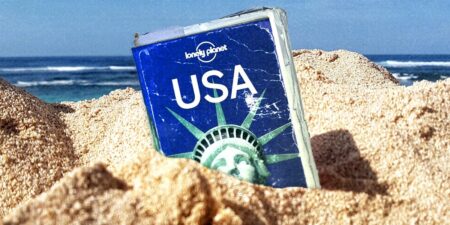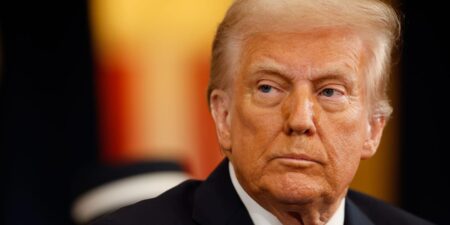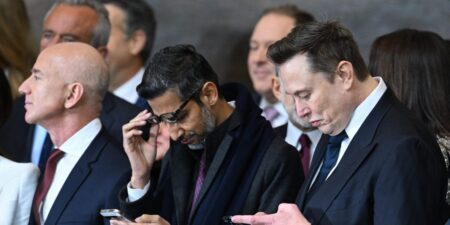The U.S. dollar is off to a weak start this year falling by more than 5% on a trade-weighted basis from its high. Moreover, the dollar’s decline may just be starting: The day after President Donald Trump’s “Liberation Day” announcement, the Bloomberg Dollar Spot Index experienced its sharpest intraday decline of 2.1% since its launch in 2005.
Investors might shrug off a pullback of this magnitude considering the dollar appreciated by 18% in the past three years. However, they appear to be searching for a new safe haven asset, with the price of gold surging by 17% this year to an all-time high around $3,100.
The dollar’s weakening does not stem from monetary policy developments. The Federal Reserve kept the federal funds rate unchanged in the first quarter, while the European Central Bank lowered official interest rates by 0.5% and is poised to make further cuts. Consequently, short-term interest rate differentials have moved in the dollar’s favor.
The main factor weighing on the dollar is the global trade war that Trump launched. He initiated it with tariffs on products from Canada, Mexico and China and has since expanded it to other countries in his April 2 announcement. Trump stated that the U.S. would apply across-the-board tariffs of 10% on all imports and that much higher reciprocal tariffs would apply to countries deemed to pursue “unfair” trade practices against the U.S. based on the bilateral surpluses they run.
This action represents a rupture of the post-war international trade regime that was based on the principle of most favored nation.
The head of economic research at Fitch Ratings estimates that the reciprocal tariffs will increase the effective tariff rate on U.S. imports to about 22% from 2.5% in 2024, according to Reuters. This increase is bigger than the Smoot-Hawley Tariff Act during the Great Depression, and it could move higher if U.S. trading partners retaliate, which is highly likely.
These developments have increased the likelihood that the U.S. may experience stagflation, in which economic activity slows while inflation picks up. The latest CNBC Rapid Update of forecasts of 14 economists, which was taken before Trump’s reciprocal tariffs were unveiled, called for economic growth in the first quarter to be only 0.3%, while core PCE inflation is projected to remain close to 3%.
Meanwhile, the risk of a global recession has increased if the reciprocal tariffs are not rescinded soon.
Amid all this, the dollar’s decline thus far has been benign, with the 10-year Treasury yield having fallen by about 0.75% from the January peak. This suggests investors currently are focused on the dampening effect of tariffs on economic activity rather than on the impact of higher prices.
However, the possibility of a dollar crisis — in which U.S. bond yields rise significantly while the dollar weakens — should not be ruled out, especially if inflation expectations rise.
The last time the dollar operated in the “crisis zone” was in 1987. The circumstances leading to it where the dollar had been exceptionally strong in the first half of the 1980s in response to high U.S. interest rates, which contributed to a widening of the U.S. trade deficit and a slowing of the U.S. economy. The U.S. and other members of the Group of Seven (G7) signed the Plaza Accord in September of 1985 to correct the dollar’s overshoot, which enabled the Fed to ease monetary policy.
By early 1987, however, the dollar had fallen precipitously against the Japanese yen and the deutschemark, and Treasury yields rose as foreign investors held off buying U.S. bonds. Accordingly, a new agreement, the Louvre Accord, was reached to stabilize the dollar. When it was abrogated over a monetary policy dispute in October 1987, the dollar was in virtual free fall as Treasury yields surged by 0.5% and the U.S. stock market sold off by more 20% in a single day. Policymakers quickly patched over their differences to stabilize the dollar and financial markets, which proved successful.
There is talk on Wall Street now that Trump’s tariff policy is part of an orchestrated plan to force the world’s leaders to strengthen their currencies to help U.S. manufacturing and to prod them to build factories in the U.S.
The origin for the idea, which has been dubbed the “Mar-A-Lago” accord, is a paper that Stephen Miran, the current chair of the Council of Economic Advisers, wrote while he worked for a hedge fund. However, Miran concedes that such an agreement is not in the cards, especially considering that Trump’s negotiating style favors bilateral agreements over multilateral agreements.
Thus far, Trump has been calling the shots on trade. He has been dictating the terms that America’s trading partners must accept if they do not want to be subject to higher tariffs. And, if they opt to retaliate, he has indicated he will reciprocate.
However, the actions Trump has taken on tariffs and his tilt toward Russia and away from Ukraine are creating a backlash, as America’s allies realize the U.S. may no longer be a trusted partner. The editorial board of the Wall Street Journal writes: “Mr. Trump is shattering that trust as he punishes allies and blows up the USMCA that he negotiated in his first term.”
This is all taking place when the U.S. has a “twin deficit” problem similar to the mid-1980s. The U.S. current account deficit is running at 4% of gross domestic product while the federal budget deficit is 6% of GDP (see chart below). Accordingly, the ability to finance these imbalances on favorable terms hinges on the willingness of foreign entities — both public and private — to hold dollar-denominated assets.
Foreign investors were willing to do so previously, because they viewed U.S. policies favorably and took comfort from being under the U.S. security umbrella. However, if President Trump continues down the path of raising tariffs indiscriminately while also undermining security alliances, global investors may rethink their strategies.
Gold has been the asset of choice thus far, but investors could diversify into other reserve currencies, as well. Goldman Sachs’ currency team, for example, believes the Japanese yen is a likely beneficiary should the global trade conflict escalate, and the euro has also strengthened. Meanwhile, equity investors have begun shifting allocations away from the U.S. stocks to European and other international markets.
The test ahead is whether the breach in the post-war order can be reconciled. Unfortunately, economic conditions may have to deteriorate further to convince Trump that he does not have the cards to win a global trade war. If trade relations are severed, the fallout could rival the breakdown of Bretton Woods system of fixed exchange rates in the early 1970s that was accompanied by stagflation, U.S. dollar weakness and high market volatility.
Read the full article here















